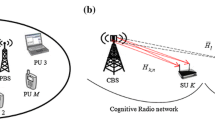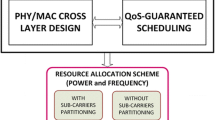Abstract
Adaptive Radio Resource Allocation exploiting the inherent frequency selectivity of the wireless medium as well as the multi-user diversity effect is expected to play a crucial role in providing high QoS on emerging OFDMA-based wireless networks. Although a plethora of studies concerning exclusively constant bit rate (CBR) or variable bit rate/best effort (BE) traffic has been published to date, limited amount of work has been devoted to the more practical mixed CBR-BE data traffic scenario over OFDM radio access networks. In this paper we attempt to deal with the specific heterogeneous allocation problem, namely the maximization of elastic users’ sum-throughput while providing minimum data rate service to a subset of non-elastic users. The contribution of this work is twofold. First, due to the high complexity of the resource allocation problem, we propose a relaxation method based on the prioritization of CBR- over BE-class users during the subchannel allocation procedure. We devise a method for obtaining the exact performance penalty induced by the specific hypothesis when compared to the optimal (unprioritized) decision. Secondly, we develop a polynomial complexity approximation algorithm for allocating power and bandwidth, that employs the CBR-prioritization idea. The scheme is shown to experience a relatively low performance penalty compared to its upper bound and to outperform two representative algorithms from the literature.
Similar content being viewed by others
References
Holma, H., & Toskala, A. (Eds.) (2009). LTE for UMTS—OFDMA and SC-FDMA based radio access. London: Wiley.
Andrews, J., Ghosh, A., & Muhamed, R. (2007). Fundamentals of WiMAX: Understanding broadband wireless networking. Prentice Hall Communications Engineering and Emerging Technologies Series. Englewood Cliffs: Prentice Hall.
Wong C., Cheng R., Letaief K., Murch R. (1999) Multiuser OFDM with adaptive subcarrier, bit, and power allocation. IEEE Journal on Selected Areas in Communications 17(10): 1747–1758
Chieochan S., Hossain E. (2009) Adaptive radio resource allocation in OFDMA systems: A survey of the state-of-the-art approaches. Wireless Communications and Mobile Computing Journal (Wiley) 9: 513–527
Hoo, L., Tellado, J., & Cioffi, J. (Nov., 1998). Dual QoS loading algorithms for DMT systems offering CBR and VBR services. In Proceedings of IEEE global telecommunications conference 1998, GLOBECOM ’98, vol. 1, Sydney, Australia.
Zhou, K., & Chew, Y. H. (Nov., 2007). Exact and heuristic solutions to adaptive subcarrier-and-bit allocation in multiclass multiuser OFDM systems. In Proceedings of IEEE global telecommunications conference 2007, GLOBECOM ’07, Washington, DC, USA, pp. 3724–3728.
Wang, W., Hwang, K., Lee, K., & Bahk S. (Nov., 2004) Resource allocation for heterogeneous services in multiuser OFDM systems In Proceedings of IEEE global telecommunications conference 2004, GLOBECOM ’04, 6, Dallas, Texas, USA.
Yu G., Zhang Z., Qiu P. (2007) Adaptive subcarrier and bit allocation in OFDMA systems supporting heterogeneous services. Journal of Wireless Personal Communications, Springer, Netherlands 43(4): 1057–1070. doi:10.1007/s11277-007-9283-2
Tao M., Liang Y.-C., Zhang F. (2008) Resource allocation for delay differentiated traffic in multiuser OFDM systems. IEEE Transactions on Wireless Communications 7(6): 2726–2737
Cioffi J. (1991) A multicarrier primer. Amati Communications Corporation and Stanford University, Tech. Rep, Stanford
Mogensen, P., Na, W., Kovacs, I., Frederiksen, F., Pokhariyal, A., Pedersen, K., Kolding, T., Hugl, K., & Kuusela, M. (Apr., 2007). LTE Capacity compared to the Shannon Bound. In Proceedings of vehicular technology conference, 2007. VTC2007-Spring. IEEE 65th, Dublin, Ireland, pp. 308–313.
Wolsey L. A., Nemhauser G. L. (1999) Integer and combinatorial optimization. Wiley, New York
Kim I., Park I.-S., Lee Y. (2006) Use of linear programming for dynamic subcarrier and bit allocation in multiuser OFDM. IEEE Transactions on Vehicular Technology 55(4): 1195–1207
Miettinen K. (1989) Nonlinear multiobjective optimization. Kluwer, Dordrecht
Deb K. (2001) Multi-objective optimization using evolutionary algorithms. Wiley, London
Jang J., Lee K. (2003) Transmit power adaptation for multiuser OFDM systems. IEEE Journal on Selected Areas in Communications 21(2): 171–178
Li, Y., Stüber, G. (eds) (2006) Orthogonal frequency division multiplexing for wireless communications. Springer, Berlin
Gotsis, A., Constantinou, P. (Oct., 2008). Adaptive Single-Cell OFDMA Resource Allocation for Heterogeneous Data Traffic. In Proceedings of IEEE 4th international conference on wireless and mobile computing, networking and communications, WiMob’08, Avignon, France, pp. 96–103.
Lee H.-W., Chong S. (2008) Downlink resource allocation in multi-carrier systems: Frequency-selective vs. equal power allocation. IEEE Transactions on Wireless Communications 7: 3738–3747
Lewis R. M., Torczon V. (1999) Pattern search algorithms for bound constrained minimization. SIAM Journal on Optimization 9(4): 1082–1099
The MATLAB Genetic Algorithm and Direct Search Toolbox. Software, Mathworks. [Online]. Available: http://www.mathworks.com/products/gads/.
Hentilä, L., Kyösti, P., Käske, M., Narandzic, M. & Alatossava, M. (2007). MATLAB implementation of the WINNER Phase II Channel Model ver1.1, IST-WINNERII Project, Dec. 2007. [Online]. Available: http://www.ist-winner.org/phase_2_model.html.
Holmström, K. (1999). The TOMLAB Optimization Environment in Matlab. Journal of Advanced Modeling and Optimization, 1(1), 47–69. [Online]. Available: http://tomopt.com/docs/TOMLAB.pdf.
Jeruchim M. C., Balaban P., Shanmugan K. S. (2000) Simulation of communication systems: Modeling, methodology and techniques, 2nd edn. Springer, Berlin
Author information
Authors and Affiliations
Corresponding author
Additional information
This paper is part of the 03ED184 research project, implemented within the framework of the “Reinforcement Programme of Human Research Manpower” (PENED) and co-financed by National and Community Funds (20% from the Greek Ministry of Development-General Secretariat of Research and Technology and 80% from E.U.-European Social Fund).
Rights and permissions
About this article
Cite this article
Gotsis, A.G., Koutsokeras, N.T. & Constantinou, P. Adaptive Power and Subchannel Allocation for Dual-Class OFDMA Packet Data Networks. Wireless Pers Commun 64, 681–702 (2012). https://doi.org/10.1007/s11277-010-0212-4
Published:
Issue Date:
DOI: https://doi.org/10.1007/s11277-010-0212-4




